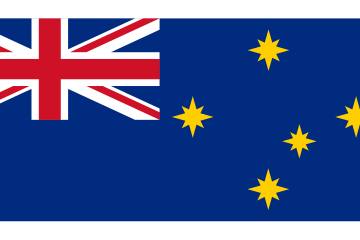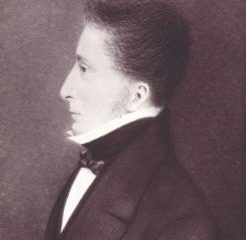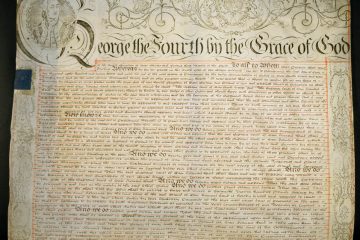Click on these links for Part 1 | Part 2 | Part 3 | Part 4 | Part 5
In August, 1851, when the English Parliament passed the Australian Constitutions Act it confirmed legislative powers on VDL. A blended legislative council could now be established: part nominated, part elected.
16 electorates were declared, dividing the colony up on the basis of the number of houses in each district.
Hobart with 3,285 houses was made into a single district and allocated 2 members. Launceston had 1,642 houses and one member.
Keen to soothe the perpetual north-south tensions, Denison allocated 6 members to the north (4,328 houses) and 10 to the south (7,362 houses).
When it came to deciding just who could vote, the men in power decided to keep the power for themselves. They limited the right to enroll to vote and stand for election by income, property and gender.
The criteria for enrolment:
1. Freehold ownership of a property worth £100 or more
2. Male British subjects
3. Over 21 years
This limited the franchise to no more than 30% of the population.
Plural voting was allowed for those who owned multiple properties each worth £100 or more. Voting in person occurred on a single day and polling booths were open only from 9-4pm.
On voting day, 21 October, 1851 there was great excitement at the polling booths in both Hobart and Launceston, where multiple contenders stood for election.
The Launceston franchise extended to just on 800 voters, and Hobart to 2,500. In both electorates, the Anti-transportationists won all the seats and drunken rowdies celebrated the wins, with several people injured in Hobart.
Things were quieter in the country districts, where the number of eligible voters was smaller, and four members were elected unopposed.
Here is the list of those elected, with the electorate they represented:
| Anstey, Henry | Oatlands |
| Archer, Joseph | Longford |
| Archer, William | Westbury |
| Chapman, Thomas | Hobart |
| Cleburne, Richard | Huon |
| Cox, James | Morven |
| Dry , Richard | Launceston |
| Dunn, John | Hobart |
| Fenton, Captain Michael | New Norfolk |
| Gleadow, John | Cornwall |
| Gregson, Thomas | Richmond |
| Kermode, Robert | Campbell Town |
| Morrison, Askin | Sorell |
| Nutt, Robert | Buckingham |
| Sharland, William | Cumberland |
| Walker, John | Brighton |
None of these men belonged to any political party, nor were they involved in factions which agree to vote together on particular issues. As a whole, however, the governor saw them all as the opposition because he could not command their vote.
Governor Dennison then announced the appointment of his 8 non-elected members of the Executive Council to the blended Legislative Council.
| Fraser, Peter | acting Colonial Secretary |
| Turnbull, Adam | acting Colonial Treasurer |
| Fleming, Valentine | Attorney-General |
| Smith, Francis | Solicitor-General |
| Allison, William | |
| Bisdee, Edward | |
| Leake, John | |
| Talbot, Hon Richard |
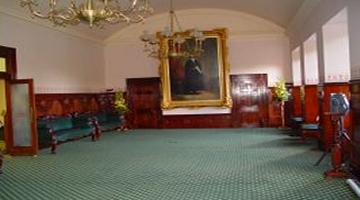
Image credit: Tasmanian Parliamentary Library
The first meeting of the new Legislative Council on 30 Dec 1851 was held in the Long Room, where the old Council had meet. It was on the first floor of what was at the time the Custom House. Now known as Parliament House, this prominent, elegant Georgian era sandstone building on Hobart’s waterfront was built by convicts to a design by colonial architect John Lee Archer.
There were significant changes to the way the new council operated. It sat for more days each year, the amount of business to be considered increased and the members were more in control of their own proceedings – especially as the governor was now excluded from parliamentary deliberations.
While the majority of the Bills came from the Executive Council presided over by the governor, the Executive did not always have its own way, and often its Bills were defeated.
| Year | Sitting days | Bills introduced | Bills passed |
| 1852 | 63 | 29 | 23 |
| 1853 | 45 | 33 | 22 |
| 1854 | 53 | 38 | 28 |
| 1855 | 75 | 49 | 33 |
This was VDL’s first partially representative government. It is clear from this analysis of the first 4 years that the blended Council was hard working, and determined not to be controlled by the wishes of the governor. The elected members, while not a faction, did operate like an effective opposition to the government, holding it to account and scrutinising its plans and motives.
One of the most important tasks undertaken by the Legislative Council was the drafting of the new Constitution for the colony, begun in 1853. Half way through they decided that what the colony really needed was a bicameral parliament – two houses, not just one. This
While this was being considered, in 1854, the membership of the Legislative Council was increased to 33 (11 nominated, 22 elected).
There was widespread popular support for further changes to be made in Van Diemen’s Land – and that was in the change of name. Many institutions had been referring to the island as Tasmania for many years and it just required the legal adoption of the new name for it to become official., which occurred in November 1855.
At this time, the population of Tasmania was declining, from 68,000 in 1847 to 61,800 in 1855. This mass departure of skilled trademen, farmers and general labourers was due to the better options available on the mainland goldfields. in this time there was a significant reduction in depredations by bushrangers thanks to the work done in regional areas by settlers and police. The last really violent, notorious bushranger in the colony was Rocky Whelan, who was executed in June 1855.
Governor Dennison left VDL in January 1855 to become governor of NSW. He was replaced by Henry Fox-Young, whose job it was to oversee the government of Tasmania.
In May, 1855 Royal Assent from Queen Victoria granting permission for a bicameral parliament was received, followed by permission to change the name to Tasmania.
The formal name change was declared on 1st January 1856 and elections for the new House of Assembly were held in October year.
So now shiny new Tasmania had a shiny new bicameral parliament with a shiny new Legislative Council Chamber. This was specially constructed for the purpose in the Custom House and apart from the electric lighting, little has changed since.
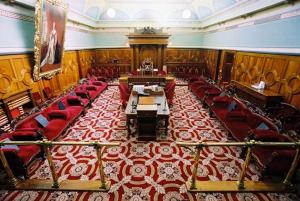
Image credit: Parliament House, Hobart
The House of Assembly sat in the Long Room, where they had to decide on the people who would fill the various roles, in particular who would be the first Premier of Tasmania?
Find out who, how and more in Part 7 – coming soon.
